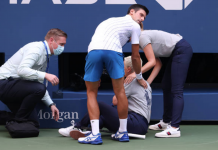Andy Roddick was peeved, but in a positive way.
After former University of Georgia standout John Isner fell to the now No. 5-ranked Juan Martin Del Potro in two tiebreaks, and Isner’s buddy Sam Querrey lost a third-set breaker to Stan Wawrinka in the fourth round of the BNP Paribas Open on the same day, Roddick slapped his palms in frustration.
“With our guys, you just want to see them do well on a consistent basis,” Roddick said. “It’s great if they’re having a good week. You want to start seeing it every week…There’s no question that John has a big enough game. I’m glad to see that he’s playing more aggressively. For him to hit and stay back, he needs to go for it. From what I’ve seen, he’s been doing that.”
Isner would likely agree with Roddick’s assessment. He has talent, but an unusual kind in the 21st century, when many matches are by won sprinting across the baseline. Many days, the 6-foot-10 player’s success hangs on whether he can gun 140 mph serves, or mule-kick in second serves, which he considers to be his most effective foray. Isner is ranked outside of the top 100, which he doesn’t believe reflects his talent level. But at Indian Wells, in his 6-7(5), 6-1, 6-4 upset of No. 9 Gael Monfils and a 6-4, 6-4 takedown of two-time Slam champ Marat Safin, he sure looked like a player with top-50 stuff (at least).
“I’m preparing well,” Isner said. “In my off days, I’m doing the right things. I’m getting in the gym. I’m practicing the right way. Mentally, I’m sharp. As clichéd as it sounds, I just need to continue to get better on the practice court, mix up, add some more variety to my game. I’m coming to the net more. When I’m at the net, I’m more aware of my surroundings. I’m playing a lot better up there, and that’s helped me out.”
Someone told Isner after the Monfils match that he came to the net 50 times and won the point on 40 occasions — a heck of a positive. He’ll never be quick, and his groundstrokes still need a lot of work, but if he can dominate at the cords, he can be trouble for anyone on a great serving day.
After a decent break out in ‘07 post his successful UGA career, Isner fell back in ‘08, and this year, prior to Indian Wells, his only decent run was in Auckland, where he qualified and reached the quarters. But then he fell in brutal heat in Melbourne (“I sweat too much and cramped”), lost a tough three-setter to fellow American Mardy Fish in San Jose, and followed that up with two lousy performances in Memphis and Delay Beach. He pulled out of the doubles in Delray and then went back to the Saddlebrook Academy to work with his new coach, Craig Boynton, who also coaches Fish.
He couldn’t find any rhythm and was unhappy with his game, so he hit the gym two hours a day and the practice court for another three. Now he’s feeling fitter and more upbeat. Plus, he has a better handle on how he can improve. He doesn’t feel like he has to live at the net to have a successful career, but it wouldn’t hurt him to spend some time punching crisp volleys.
“Obviously, I want to get to the net as much as possible, but my forehand is also one of my better shots. I like to take a lot of chances on second serves and crack a second serve return with my forehand. When I’m at the back, I’m going to be looking for a forehand. I can still hang from the baseline, but, ideally, I need to be at net. But I’m not intimidated when I’m at the back.”
Isner still gets advice from his former coach, UGA’s Manny Diaz, whom he speaks with at least once a week. Even though Diaz can’t travel with him, he’s still one of Isner’s primary mentors.
“I just talk to him about everything. He’s a good friend. If it weren’t for him, I wouldn’t be here right now. He’s a great coach, and I’m always going to pick his brain. He’s a great motivator. In the college atmosphere, he was always able to get our team ready to play every single match. A good example was last year. We weren’t the most talented team. I wasn’t on the team, but they still won it all. That can be contributed to coach Diaz.”
The week after Indian Wells, Isner qualified for Miami, eventually falling to Spaniard David Ferrer. But he kept churning, even on a serve-and-volleyer’s least favorite surface — clay — on which he reached the Houston quarters. His ranking is up to No. 126 — nearly 20 spots away from automatic Slam qualification — but much better than in February, when he had nearly lost all his rhythm.
“I needed to get back to the drawing board,” he said. “I play my best when I’m pumped up, but I need to keep my composure. I’m really disgusted with my ranking, but last year I lost some really tough matches and never put together a really good run. I got in a little over my head. But now with Craig, he knows my game and we’ve been working a lot on my net play, especially my balance at the net, specifically waiting for the ball at the net because with my reach, if I can just wait a little longer, I’m in much better shape.”


















